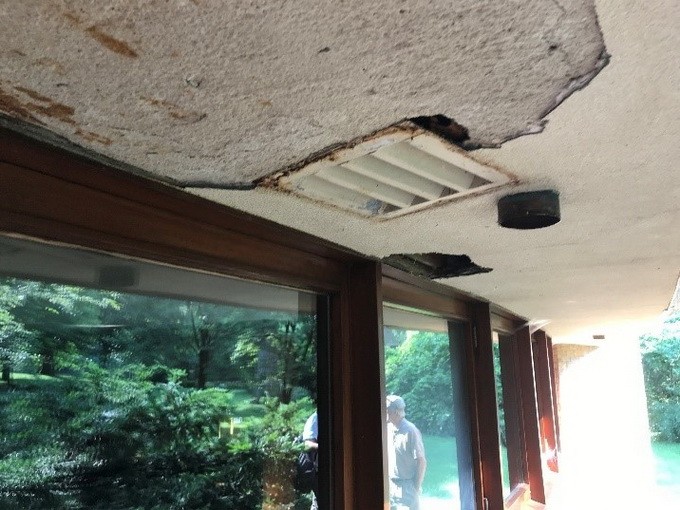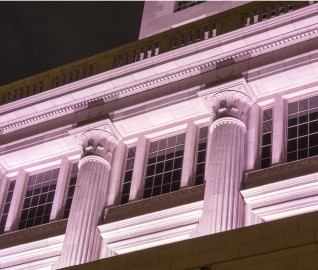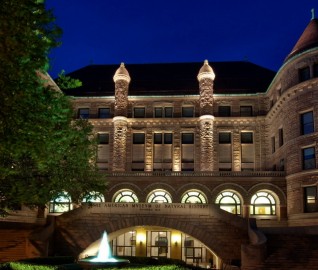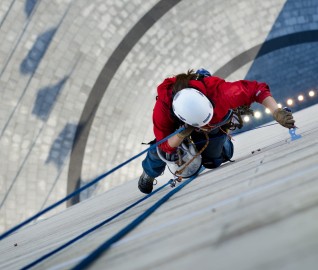NEWS | January 25, 2024
Frank Lloyd Wright's Laurent House Exemplifies Commitment to Historic Preservation

Since the start of WJE’s pro bono program in 2014, employees have volunteered their time and expertise to more than 120 projects—close to one-third of which involved historic structures—restoring everything from a boathouse foundation at Cape Decision Lighthouse in Alaska to a cemetery gatehouse in Philadelphia. Most or all of the costs associated with these efforts were covered by WJE.
Employees have even worked on structures designed by famous architects, including a house created by one of the most legendary of all, Frank Lloyd Wright.
Built in 1952 and predominantly semicircular in plan, the Laurent House in Rockford, Illinois, was conceived to provide wheelchair accessibility for Kenneth Laurent, a disabled veteran, and his wife Phyllis. They lived there for sixty years. After Kenneth passed away, the building was listed on the National Register of Historic Places, and the Laurent House Foundation purchased the home.
The Foundation conducted interior and exterior repairs, including modifications to the roof framing to accommodate central air conditioning and replacement of the entire roofing system. The work began in 2013. After adding Wright-designed drawings and furnishings along with the Laurents’ personal effects to the interior, the Foundation opened the building to the public in 2014.
 Within two years, water damage was observed at the stucco soffits at various locations around the exterior building perimeter. Roofing and stucco repairs were performed at the entire roof perimeter in 2017, but water damage subsequently reoccurred.
Within two years, water damage was observed at the stucco soffits at various locations around the exterior building perimeter. Roofing and stucco repairs were performed at the entire roof perimeter in 2017, but water damage subsequently reoccurred.
Enter WJE architect Steve Naggatz and his team. In June 2020, he received a call from a graduate school classmate and friend, Ann Darby, who grew up in Rockford.
“When Ann reached out to me to help solve a water-leakage problem on a single-family house in Rockford, my response was, ‘How soon do you need us there?’” Naggatz recalled. “The fact that this little gem of a house was originally designed by Frank Lloyd Wright for a disabled veteran made the opportunity even more appealing.” As is often the case with non-profit groups, the Laurent Foundation was cash-strapped and needed pro bono help.
During the team’s initial site visit, team members asked if the Foundation could lend a garden hose and spray nozzle to try to quickly replicate leaks.
“We were successful,” Naggatz said. “We were able to re-create water leaks at locations of previous stains in concealed soffit locations. Our testing wasn’t extraordinary, but we did enough work to satisfy that the damage was the result of concealed deficiencies at soffit drains and at the roof-wall (fascia) interface.”
Still, the timeline of events was challenging.
“We were being asked to piece together a story that developed over the course of the previous seven years,” Naggatz noted. “While we are well equipped to perform destructive water leakage investigations, doing so would have resulted in additional cost for contractor support (to make and repair exploratory openings) and the financial burden of paying WJE and another contractor to execute an investigation when our budget for the project was relatively small.”
But the result was worth it. In 2021, Naggatz received an e-mail from The Laurent Foundation that the work had been resolved to its satisfaction. A historic structure was preserved in top-notch shape for future generations—the type of result WJE hoped for when it launched its pro bono program a decade ago to benefit employees who wanted to give back to organizations in need.
RELATED INFORMATION
-
 Our professionals balance the need to provide practical, long-term solutions with the ability to... MORE >Services | Historic Preservation
Our professionals balance the need to provide practical, long-term solutions with the ability to... MORE >Services | Historic Preservation -
 Our professionals deliver practical repair and rehabilitation services that maximize the... MORE >Services | Repair and Rehabilitation
Our professionals deliver practical repair and rehabilitation services that maximize the... MORE >Services | Repair and Rehabilitation -
 We apply the lessons learned from more than 175,000 projects to provide clients with a full... MORE >Services | Condition Evaluation
We apply the lessons learned from more than 175,000 projects to provide clients with a full... MORE >Services | Condition Evaluation -
 Steven G. Naggatz, Associate PrincipalWJE Chicago MORE >People | Steven G. Naggatz, Associate Principal
Steven G. Naggatz, Associate PrincipalWJE Chicago MORE >People | Steven G. Naggatz, Associate Principal



































